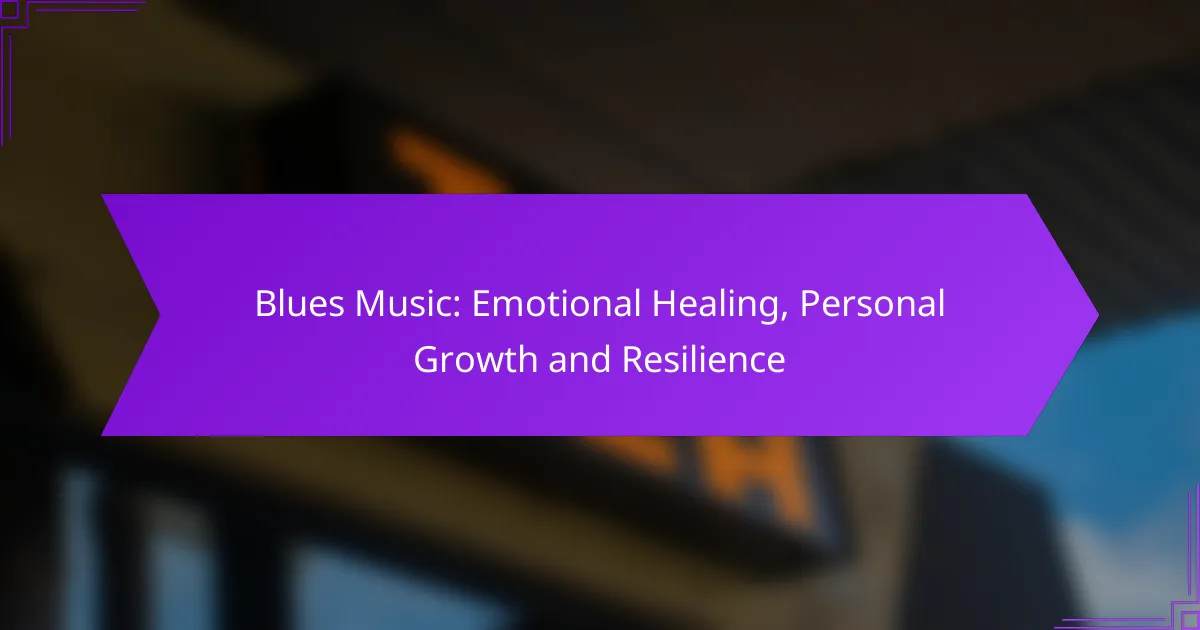When deciding between blues and jazz, it’s essential to consider the atmosphere and audience size of your event. Blues excels in intimate settings, offering deep emotional expression and storytelling, while jazz thrives in larger venues with its complex improvisation and versatility. Each genre has its unique strengths, making them suitable for different occasions and moods.
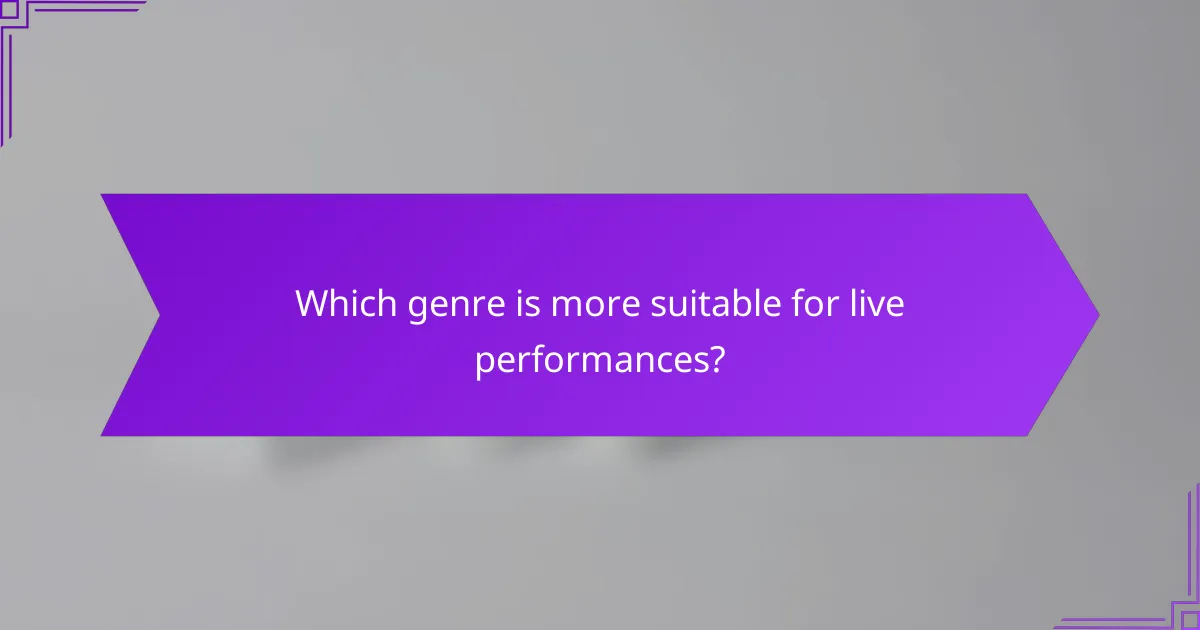
Which genre is more suitable for live performances?
Blues is often more suitable for intimate venues, while jazz tends to excel in larger settings. The choice between these genres depends on the atmosphere you want to create and the audience size.
Blues for intimate venues
Blues music thrives in smaller, cozy spaces where the connection between the performer and audience is palpable. Venues like bars, cafes, and small clubs can enhance the emotional depth of blues, allowing for a more personal experience.
When performing blues, consider the acoustics and ambiance of the venue. A small stage with good sound quality can make a significant difference. Aim for venues that can accommodate around 50 to 150 people for the best experience.
Jazz for larger audiences
Jazz is well-suited for larger audiences and venues, such as concert halls and festivals, where the complexity and improvisational nature of the music can be fully appreciated. The dynamic range of jazz allows it to fill bigger spaces effectively.
For jazz performances, consider venues that can host hundreds of attendees, as this genre often benefits from a lively atmosphere. Ensure that the sound system is capable of handling the nuances of jazz to maintain clarity and richness across the audience.

When should you choose blues over jazz?
Choose blues when you want to convey deep emotional expression and storytelling, often rooted in personal experiences. Blues is characterized by its distinct chord progressions and lyrical themes that resonate with feelings of sorrow, resilience, and hope.
Emotional storytelling
Blues excels in emotional storytelling, using lyrics to express personal struggles and triumphs. The genre often features themes of heartbreak, loss, and perseverance, allowing musicians to connect intimately with their audience.
For example, a classic blues song might recount a tale of lost love or hardship, using vivid imagery and relatable emotions. This narrative style invites listeners to reflect on their own experiences, creating a powerful bond between the artist and the audience.
Traditional roots
Blues has strong traditional roots, originating from African American communities in the Deep South of the United States. It draws from spirituals, work songs, and folk music, making it a foundational genre that influenced many other styles, including jazz.
When choosing blues, consider its historical context and cultural significance. The genre often incorporates specific instruments like the guitar and harmonica, and its structure typically follows a 12-bar format, which can be a defining characteristic when performing or composing.
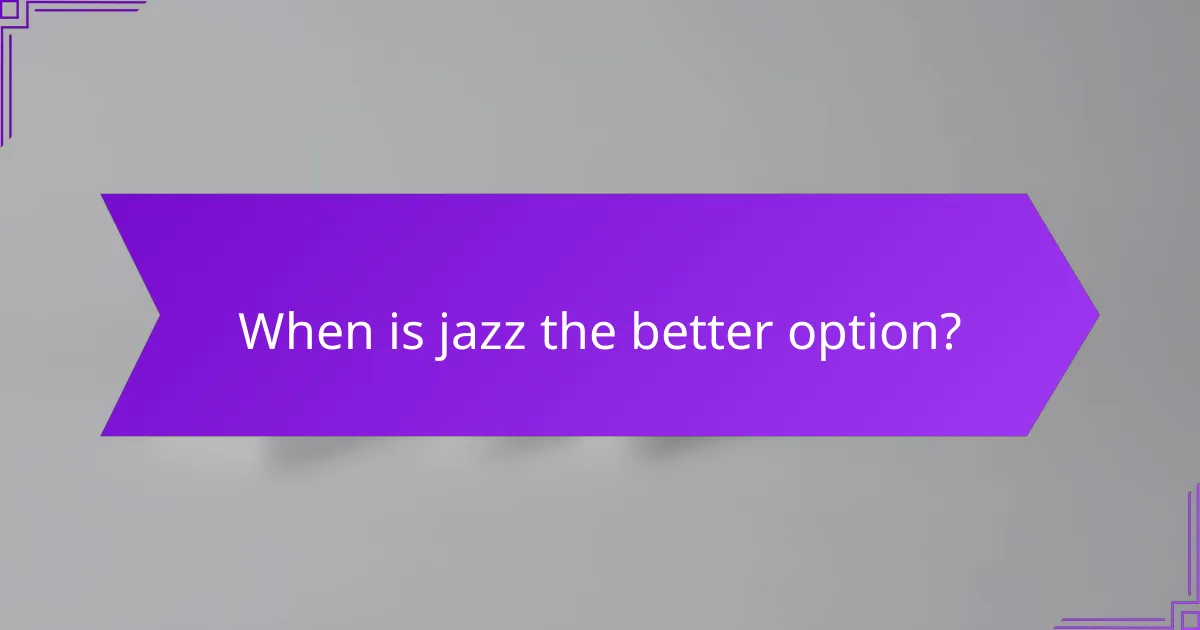
When is jazz the better option?
Jazz is often the better choice when you need complex improvisation and a wide variety of styles. Its flexibility allows musicians to express creativity and adapt to different moods and settings, making it suitable for diverse occasions.
Complex improvisation
Jazz is characterized by its intricate improvisation, allowing musicians to create spontaneous melodies and harmonies. This complexity can elevate performances, making them unique and engaging for audiences. Musicians often use techniques like call and response, syncopation, and polyrhythms to enhance their improvisational skills.
When selecting jazz for an event, consider the level of improvisation desired. For instance, a small jazz combo may offer more personal and intricate improvisations compared to a larger big band, which often focuses on arranged pieces with less spontaneous variation.
Variety of styles
Jazz encompasses a broad range of styles, from bebop and swing to smooth jazz and fusion. This diversity allows for tailored experiences that can match the atmosphere of any occasion, whether it’s a formal dinner or a lively party. Each style brings its own unique flavor and emotional resonance.
When choosing jazz, think about the specific vibe you want to create. For a relaxed setting, smooth jazz might be ideal, while a more energetic environment could benefit from bebop or swing. Understanding the different styles can help you select the right music for your event.
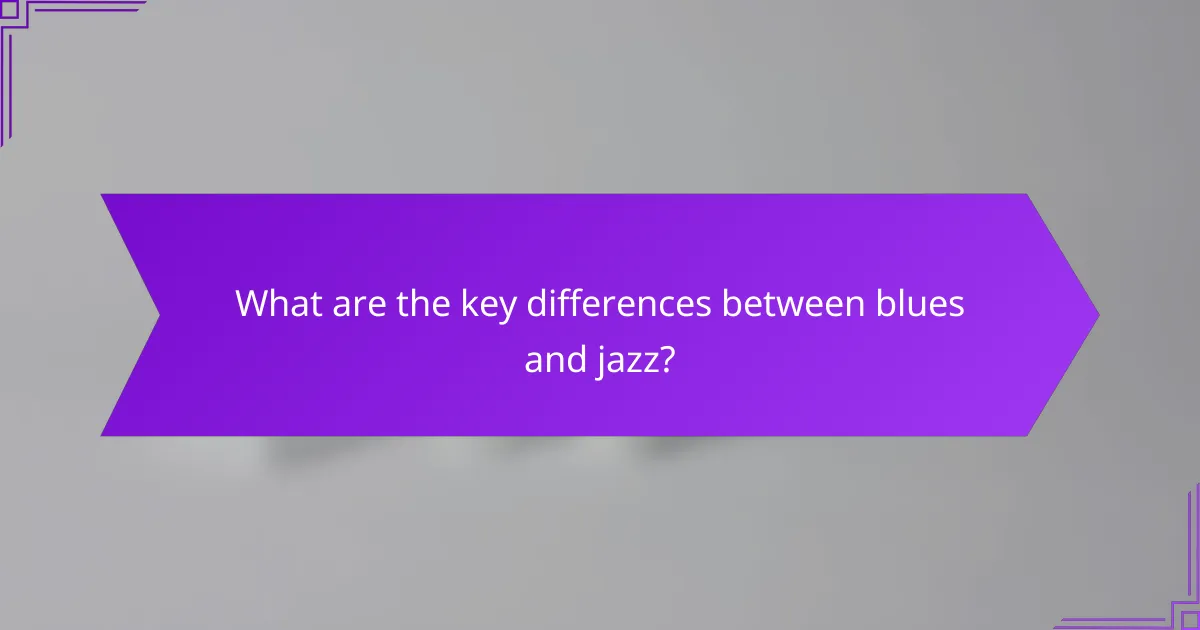
What are the key differences between blues and jazz?
Blues and jazz are distinct music genres with unique characteristics. Blues typically features a simple structure and emotional lyrics, while jazz is known for its complex harmonies and improvisation.
Musical structure
The musical structure of blues is generally straightforward, often following a 12-bar format with a repetitive chord progression. This simplicity allows for emotional expression and storytelling through lyrics.
In contrast, jazz employs more complex structures, including various time signatures and chord changes. Jazz musicians often use improvisation, which can lead to spontaneous variations in melody and rhythm, making each performance unique.
Instrumentation
Blues typically features instruments like the guitar, harmonica, bass, and drums, focusing on a raw, soulful sound. The guitar often plays a central role, using techniques such as bending notes to convey emotion.
Jazz instrumentation is more diverse, commonly including brass instruments like trumpets and saxophones, as well as pianos and double basses. This variety allows for a broader range of sounds and styles, from smooth and melodic to fast-paced and energetic.
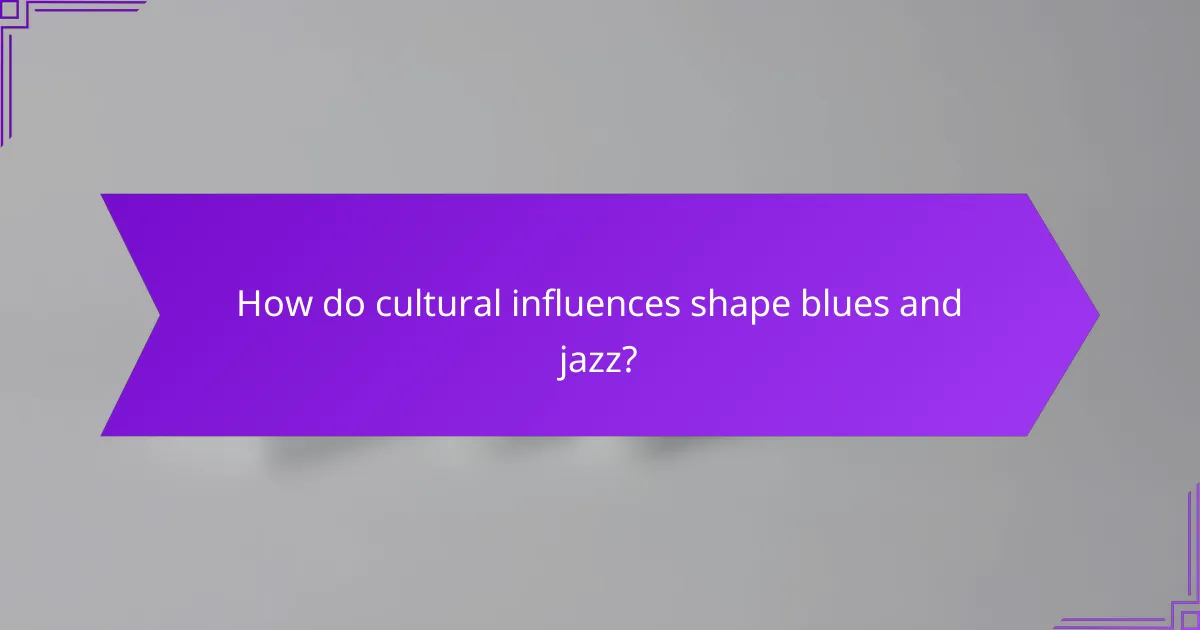
How do cultural influences shape blues and jazz?
Cultural influences play a significant role in shaping both blues and jazz, reflecting the historical and social contexts from which they emerged. Blues originated from African American experiences, while jazz evolved through a blend of various musical traditions, resulting in distinct yet interconnected genres.
Blues from African American history
The blues genre is deeply rooted in the African American experience, particularly in the Southern United States during the late 19th and early 20th centuries. It emerged from spirituals, work songs, and folk music, often expressing themes of hardship, love, and resilience.
Musicians used simple chord progressions, typically in a twelve-bar format, allowing for emotional expression and improvisation. Notable artists like B.B. King and Muddy Waters helped popularize the genre, influencing countless musicians and contributing to the cultural narrative of African American history.
Jazz’s global evolution
Jazz began in the early 20th century, primarily in New Orleans, as a fusion of African rhythms, blues, and European musical traditions. This genre quickly spread across the globe, adapting to local cultures and incorporating diverse musical elements, such as Latin rhythms and classical influences.
As jazz evolved, it gave rise to various subgenres, including bebop, cool jazz, and free jazz, each reflecting different cultural contexts and artistic expressions. Prominent figures like Louis Armstrong and Duke Ellington played crucial roles in popularizing jazz internationally, making it a significant part of global music culture.
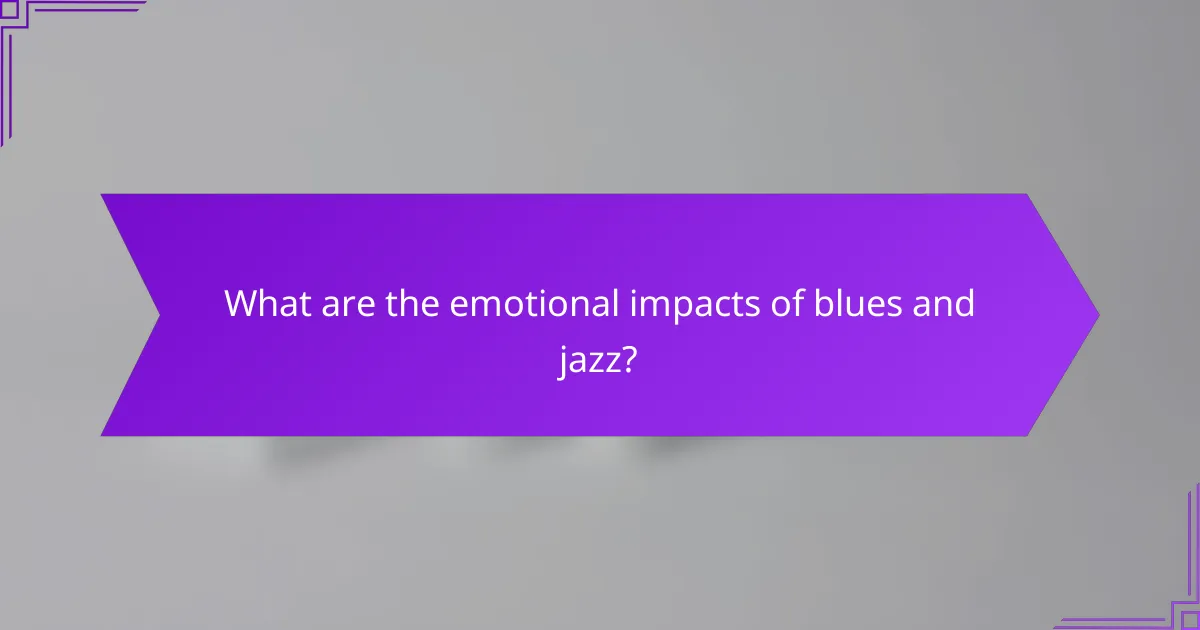
What are the emotional impacts of blues and jazz?
The emotional impacts of blues and jazz differ significantly, influencing listeners and performers in unique ways. Blues often evokes feelings of nostalgia and longing, while jazz tends to inspire creativity and spontaneity.
Blues evokes nostalgia
Blues music is deeply rooted in personal experiences and historical struggles, often conveying themes of heartache and resilience. This genre frequently taps into emotions tied to past events, making listeners reflect on their own memories and life stories.
Common elements in blues include expressive lyrics and soulful melodies that resonate with feelings of loss and yearning. For instance, a classic blues song might recount tales of love lost or hardships faced, creating a sense of connection through shared experiences.
Jazz inspires creativity
Jazz is characterized by its improvisational nature, encouraging both musicians and listeners to explore new ideas and express themselves freely. The spontaneous elements of jazz can spark inspiration, making it a popular choice for creative environments.
In practice, jazz often features complex rhythms and harmonies that challenge traditional musical boundaries. This encourages musicians to experiment and innovate, leading to a dynamic listening experience that can stimulate creative thinking in various settings, from casual gatherings to professional artistic endeavors.
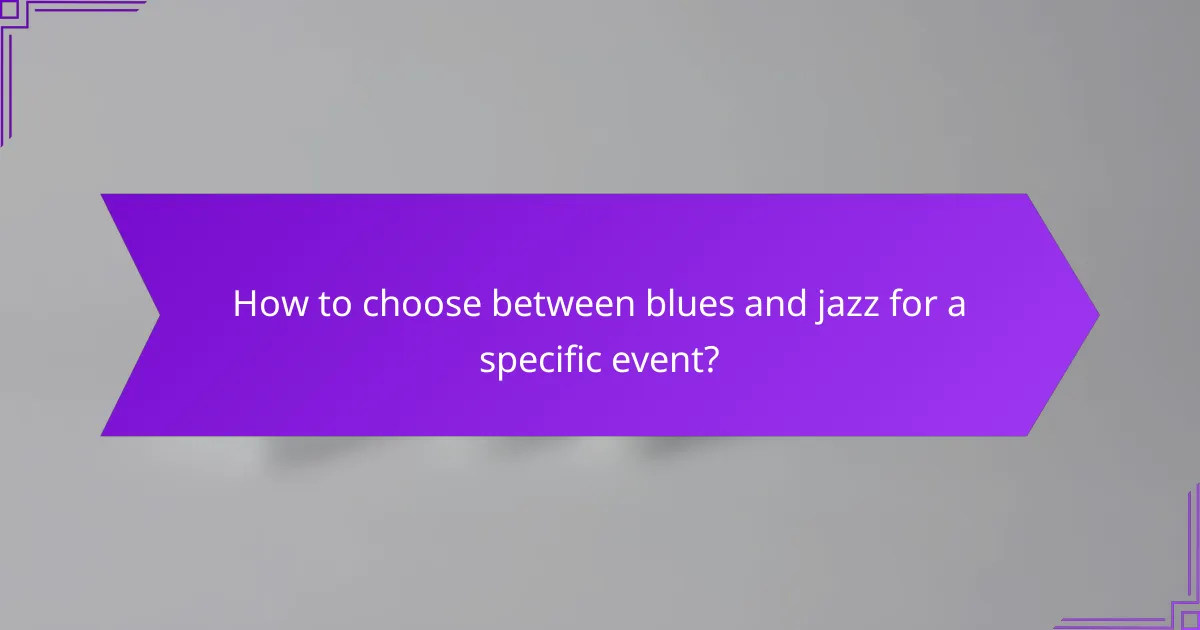
How to choose between blues and jazz for a specific event?
Choosing between blues and jazz for an event depends on the audience’s preferences and the overall theme of the gathering. Blues tends to evoke a more emotional, soulful atmosphere, while jazz offers a sophisticated, improvisational vibe.
Audience demographics
Understanding your audience is crucial when selecting between blues and jazz. Blues often appeals to a diverse crowd, particularly those who appreciate storytelling and emotional depth in music. Jazz, on the other hand, might attract a more niche audience that enjoys complex rhythms and improvisation.
Consider the age group and cultural background of your attendees. For example, younger audiences may lean towards jazz, especially if they are familiar with contemporary jazz fusion, while older crowds might prefer the classic sounds of blues.
Event theme
The theme of your event plays a significant role in the choice between blues and jazz. If the event is casual or focused on storytelling, blues can create an intimate, relatable atmosphere. Conversely, if the event is formal or artistic, jazz can enhance the sophistication and elegance of the occasion.
For themed events like a Southern barbecue, blues would fit perfectly, while a gallery opening or cocktail party might benefit from the lively and intricate nature of jazz. Always align the music style with the overall mood you want to create.

What are the best blues and jazz festivals in the US?
The best blues and jazz festivals in the US showcase top talent and vibrant culture, attracting music lovers from across the country. Notable events include the New Orleans Jazz & Heritage Festival and the Chicago Blues Festival, each offering unique experiences and a rich lineup of artists.
New Orleans Jazz & Heritage Festival
The New Orleans Jazz & Heritage Festival, often referred to as Jazz Fest, is one of the most celebrated music festivals in the US. Held annually in late April to early May, it features a diverse range of artists from jazz, blues, and beyond, along with local cuisine and crafts.
Visitors can expect to see performances from both legendary musicians and emerging talent across multiple stages. The festival typically spans two weekends, making it a prime destination for music enthusiasts seeking a deep dive into the cultural fabric of New Orleans.
Chicago Blues Festival
The Chicago Blues Festival is a free event that celebrates the city’s rich blues heritage. Usually taking place in June, it features a lineup of renowned blues artists and up-and-coming musicians performing at various venues throughout the city.
This festival not only highlights live music but also offers workshops and discussions about the history and impact of blues music. It’s an excellent opportunity for attendees to immerse themselves in the genre and learn from the experts.
Monterey Jazz Festival
The Monterey Jazz Festival, established in 1958, is one of the longest-running jazz festivals in the world. Typically held in September, it showcases a mix of established jazz legends and contemporary artists across multiple stages.
Attendees can enjoy a variety of performances, from big bands to intimate solo acts. The festival also features educational programs and workshops, making it a great choice for both casual listeners and serious jazz aficionados.
Blues from the Top
Blues from the Top takes place in Winter Park, Colorado, usually in July. This festival emphasizes the blues genre while also incorporating elements of rock and soul, attracting a diverse audience.
The event features multiple stages and a range of food and craft vendors, creating a lively atmosphere. It’s an ideal setting for those looking to enjoy great music in a beautiful mountain backdrop.



